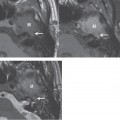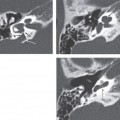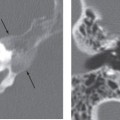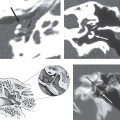CHAPTER 13 Melanoma
Epidemiology
Primary melanoma may occur on any skin surface where melanocytes normally or abnormally are present. Melanoma of the pinna compromises 7 to 14% of all melanomas of the head and neck, though it is extremely rare to have involvement of the external auditory canal. Involvement of the cutaneous surfaces most commonly occurs on the helix or the antihelix of the pinna or in the region of the external auditory meatus, as these regions receive intense sun exposure. The mean age at diagnosis for head and neck melanomas tends to between 60 and 70 years of age. Tumors involving ears are more common in males than females.
Clinical Features
Involvement of the external auditory meatus may either represent extensive lesions that originate in the pinna and extend into the external auditory canal, or primarily involve the meatus of the external auditory canal. Primary involvement of the canal has only rarely been reported. Most cases present with hearing loss and otorrhea. The lesion on physical examination may represent a dark fleshy mass or a pink-gray polypoidal mass.
Pathology
Staging of melanomas is based on the tumor, node, metastasis (TNM) classification. The primary tumor (T) is subdivided as follows: Tx, primary tumor cannot be assessed; T0, no evidence of primary tumor; Tis, melanoma in situ; T1, melanoma is 1.0 mm in thickness; T2, melanoma is 1.01 to 2.0 mm; T3, melanoma is 2.01 to 4.0 mm; and T4, melanoma is >4.0 mm.
Stay updated, free articles. Join our Telegram channel

Full access? Get Clinical Tree








